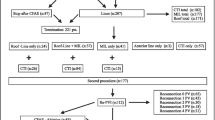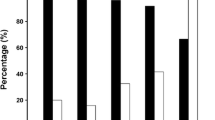Abstract
Background
An effective therapy of persistent atrial fibrillation beyond pulmonary vein isolation remains unsatisfactory. Targeting endocardial low-voltage areas represents an approach of substrate modification. This prospective, randomized study investigated the efficacy of ablation of low-voltage areas versus PVI and additional linear ablations in patients with persistent atrial fibrillation in terms of single-procedure arrhythmia-free outcome and safety.
Methods and results
A total number of 100 patients undergoing de-novo catheter ablation for persistent AF were randomized in a 1:1 ratio into two different treatment arms: group A: pulmonary vein isolation (PVI) and, if low-voltage areas were present, a substrate modification. Group B: PVI and, if atrial fibrillation persisted, additional ablations, such as linear ablation and/or ablation of non-PV triggers. A total of 50 patients were randomized into each group without significant differences in baseline characteristics. During a mean follow-up of 17.64 ± 4.5 months after a single procedure, 34 (68%) patients of group A were free of arrhythmia recurrence versus 28 (56%) patients in group B (p = ns). In group A, 30 (60%) patients did not show endocardial fibrosis and received solely PVI. Both procedures were performed with a low number of complications; no pericardial effusion or stroke were seen in either group.
Conclusions
A significant proportion of patients with persistent atrial fibrillation do not show low-voltage areas. A total of 70% of the patients receiving solely PVI did not show any recurrence of atrial fibrillation, and therefore, extensive additional ablation should be avoided in de-novo patients.
Graphical Abstract




Similar content being viewed by others
References
Haissaguerre M, Jais P, Shah DC, Takahashi A, Hocini M, Quiniou G, Garrigue S, Le Mouroux A, Le Metayer P, Clementy J. Spontaneous initiation of atrial fibrillation by ectopic beats originating in the pulmonary veins. N Engl J Med. 1998;339(10):659–66.
Rolf S, Kircher S, Arya A, et al. Tailored atrial substrate modification based on low-voltage areas in catheter ablation of atrial fibrillation. Circ Arrhythm Electrophysiol. 2014;7(5):825–33.
Kottkamp H, Berg J, Bender R, Rieger A, Schreiber D. Box isolation of fibrotic areas (BIFA): a patient-tailored substrate modification approach for ablation of atrial fibrillation. J Cardiovasc Electrophysiol. 2016;27(1):22–30.
Jadidi AS, Lehrmann H, Keyl C, Sorrel J, et al. Ablation of persistent atrial fibrillation targeting low-voltage areas with selective activation characteristics. Circ Arrhythm Electrophysiol. 2016;9(3):e002962. https://doi.org/10.1161/CIRCEP.115.002962
Yang G, Zheng L, Jiang C, Fan J, et al. Circumferential pulmonary vein isolation plus low-voltage area modification in persistent atrial fibrillation. The STABLE-SR-II Trial. JACC: Clinical Electrophysiology. 2022;8(7):882–91.
Bisbal F, Benito E, Teis A, et al. Magnetic resonance imaging-guided fibrosis ablation for the treatment of atrial fibrillation: the ALICIA trial. Circ Arrhythm Electrophysiol. 2020;13(11): e008707.
Marrouche NF, Greene T, Dean JM, et al. Efficacy of LGE-MRI-guided fibrosis ablation versus conventional catheter ablation of atrial fibrillation: the DECAAF II trial: Study design. J Cardiovasc Electrophysiol. 2021;32(4):916–24.
Mannion J, Galvin J, Boles U. Left atrial scar identification and quantification in sinus rhythm and atrial fibrillation. J Arrhythm. 2020;36(6):967–73.
Huang T, Chen J, Muller-Edenborn B, et al. Validating left atrial fractionation and low-voltage substrate during atrial fibrillation and sinus rhythm-a high-density mapping study in persistent atrial fibrillation. Front Cardiovasc Med. 2022;9:1000027.
Yamaguchi T, Tsuchiya T, Nakahara S, Fukui A, Nagamoto Y, Murotani K, Eshima K, Takahashi N. Efficacy of left atrial voltage-based catheter ablation of persistent atrial fibrillation. J Cardiovasc Electrophysiol. 2016;27(9):1055–63.
Teh AW, Kistler PM, Lee G, Medi C, Heck PM, Spence SJ, Sparks PB, Morton JB, Sanders P, Kalman JM. The relationship between complex fractionated electrograms and atrial low-voltage zones during atrial fibrillation and paced rhythm. Europace. 2011;13(12):1709–16.
Kapa S, Desjardins B, Callans DJ, Marchlinski FE, Dixit S. Contact electroanatomic mapping derived voltage criteria for characterizing left atrial scar in patients undergoing ablation for atrial fibrillation. J Cardiovasc Electrophysiol. 2014;25(10):1044–52.
Bradfield JS, Huang W, Tung R, Buch E, Okhovat JP, Fujimura O, Boyle NG, Gornbein J, Ellenbogen KA, Shivkumar K. Tissue voltage discordance during tachycardia versus sinus rhythm: implications for catheter ablation. Heart Rhythm. 2013;10(6):800–4.
Ma J, Chen Q, Ma S. Left atrial fibrosis in atrial fibrillation: mechanisms, clinical evaluation and management. J Cell Mol Med. 2021;25(6):2764–75.
Sohns C, Marrouche NF. Atrial fibrillation and cardiac fibrosis. Eur Heart J. 2020;41(10):1123–31.
Duytschaever M, De Pooter J, Demolder A, et al. Long-term impact of catheter ablation on arrhythmia burden in low-risk patients with paroxysmal atrial fibrillation: the CLOSE to CURE study. Heart Rhythm. 2020;17(4):535–43.
Conti S, Jiang CY, Betts TR, et al. Effect of postablation monitoring strategy on long-term outcome for catheter ablation of persistent atrial fibrillation: a substudy of the STAR AF II trial. Circ Arrhythm Electrophysiol. 2020;13(11): e008682.
Rostock T, Salukhe TV, Steven D, et al. Long-term single- and multiple-procedure outcome and predictors of success after catheter ablation for persistent atrial fibrillation. Heart Rhythm. 2011;8(9):1391–7.
Huo Y, Gaspar T, Schönbauer R, Wojik M, Fiedler L, et al. Low-voltage myocardium-guided ablation trial of persistent atrial fibrillation. NEJM Evid. 2022;1(11). https://doi.org/10.1056/EVIDoa2200141
Jia H, Wang W, Yu B. Efficacy and safety of low-voltage area ablation for atrial fibrillation: a systematic review. J Interv Card Electrophysiol. 2022. https://doi.org/10.1007/s10840-022-01258-1
Yand G, Zheng L, Jiang C, Fan J, et al. Circumferential pulmonary vein isolation plus low-voltage area modification in persisnt atrial fibrillation. The STABLE-SR-II Trial. JACC. 2022;8(7):882–91.
Kistler P, Chieng D, Sugumar H, Ling L-H, et al. Effect of catheter ablation using pulmonary vein isolation with vs without posterior left atrial wall isolation on atrial arrhythmia recurrence in patients with persistent atrial fibrillation. JAMA. 2023;329(2):127–35.
Derval N, Duchateau J, Denis A, Ramirez FD, et al. Marshall bundle elimination, pulmonary vein isolation, and line completion for anatomical ablation of persistent atrial fibrillation (Marshall-PLAN): prospective, single-center study. Heart Rhythm. 2021;18(4):529–37.
Kurfirst V, Mokracek A, Bulava A, Canadyova J, Hanis J, Pesl L. Two-staged hybrid treatment of persistent atrial fibrillation: short-term single-centre results. Interact Cardiovasc Thorac Surg. 2014;18(4):451–6.
Ruaengsri C, Schill MR, Khiabani AJ, Schuessler RB, Melby SJ, Damiano RJ Jr. The cox-maze IV procedure in its second decade: still the gold standard? Eur J Cardiothorac Surg. 2018;53(1):i19-I25.
Weng W, Birnie DH, Ramirez FD, Van Stiphout C, Golian M, et al. Outcomes of a comprehensive strategy during repeat atrial fibrillation ablation. J Interv Card Electrophysiol. 2022;65:391–9.
Author information
Authors and Affiliations
Corresponding author
Ethics declarations
Ethical approval
This study was conducted in accordance with the Helsinki Declaration, and the prospective trial was approved by the local Ethics Committee. An informed written consent from every patient was obtained.
Conflict of interest
The authors declare no competing interests.
Additional information
Publisher's note
Springer Nature remains neutral with regard to jurisdictional claims in published maps and institutional affiliations.
Rights and permissions
Springer Nature or its licensor (e.g. a society or other partner) holds exclusive rights to this article under a publishing agreement with the author(s) or other rightsholder(s); author self-archiving of the accepted manuscript version of this article is solely governed by the terms of such publishing agreement and applicable law.
About this article
Cite this article
Kaiser, B., Huber, C., Pirozzolo, G. et al. Persistent atrial fibrillation without the evidence of low-voltage areas: a prospective randomized trial. J Interv Card Electrophysiol 67, 83–90 (2024). https://doi.org/10.1007/s10840-023-01564-2
Received:
Accepted:
Published:
Issue Date:
DOI: https://doi.org/10.1007/s10840-023-01564-2




